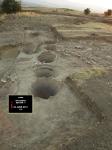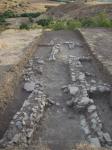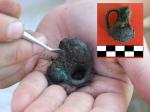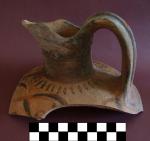Summary (English)
In 2010, a pile of stones from a Doric order building were discovered in Sector 6, which can be dated roughly to the 4th-3rd century BC. The first possibility was that stones might be from a temple, but research indicated that they probably came from a stoa or colonnade of some sort. Most of the stones (limestone) were cut up and tossed into a heap. Around this pile of stones was a mass of ash, quicklime, and crazed and cracked stones. Bits of a clay kiln and slag were also found scattered about. Analysis indicated that there were abundant trace elements of limestone – all pointing to a lime burning process. The stones were piled up near a very well preserved section of the acropolis wall and western gate.
Two walls of a building that appears to be the stoa were uncovered this season. The back wall runs at least 13.5 meters and the western side wall at least 4.25 meters. The both walls are not excavated in their full extent. The back wall is built of well-dressed stones, the lower course of blocks measuring 0.60 × 1.0 meters; the second course is of smaller stones. Stereobate courses were found beneath the ancient ground level. The discoloration and friable condition of the upper courses of stones indicate that they had been subjected to intense heat. It appears that this building is aligned with the western acropolis gate.
One of the objectives of the 2011 season was to connect the acropolis walls of Sectors 3 and 6. Just centimeters beneath the grass, a field of pithoi set down into a clay bed that had been carved into the subsoil was revealed. The pithoi must have been part of the cellar of a very substantial building, of which not a single trace remains, aside from the pithoi themselves. This building must have been incorporated somehow into the circuit of walls on the acropolis. All the pithoi had their rims smashed off and many of these rims were found inside the vessels. A very interesting moment is that many broken pithos bases were found inside these 13 pithoi, which, as mentioned, were still set in their original positions.
Another of the objectives of the 2011 season was to discover what buildings might be found on the Second Terrace (middle terrace) of the hill. 5 × 15 meter long trench was opened on the northwest part of the Second Terrace below the acropolis. Many small walls were uncovered just beneath the topsoil. The nature of the walls indicates that this might be the residential area of ancient Bylazora. The ceramic finds from this Second Terrace excavation date the occupation of these buildings to the last days of the town.
Director
- William Neidinger - Texas Foundation for Archaeological and Historical Research
Team
- Stefan Danev - Museum of Sveti Nikole
- Eulah Matthews - Texas Foundation for Archaeological and Historical Research
Research Body
- Museum of Sveti Nikole
- Texas Foundation of Archaeological and Historical Research





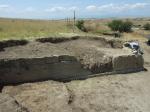
![Download [PDF]](/excavation/skins/fasti/images/results/download_sml.png)
